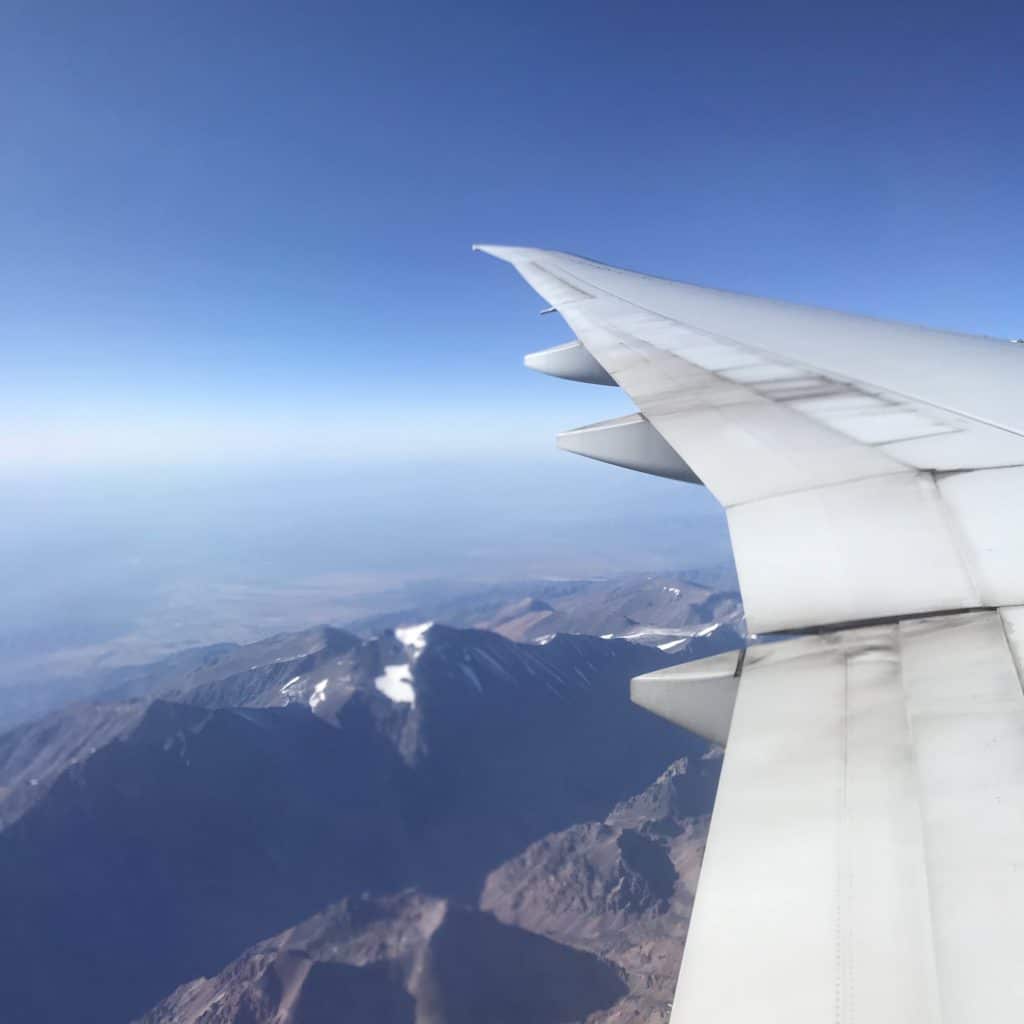It’s not a secret that I love travelling. And, I also want to protect this planet, and to enjoy its beauties. Also, I always travel with a purpose, whether to attend the UN conference on climate change, a health conferences or to Antarctica with the Homeward Bound project. But, traveling comes at a high cost to the environment. So, while I was trying to figure out the least harmful way of traveling for the environment, I did this research on how to be more environmentally conscious when flying.
The aviation industry and the environment
The aviation industry recognizes the need to address the global challenge of climate change and in 2009 adopted a set of ambitious targets to mitigate CO2 emissions from air transport. Flights produce 2% of all CO2 emissions caused by humans. The good news is that airlines can cut back on these emissions. Each new generation of aircraft is more fuel efficient than the last. It’s estimated that airlines will invest in new planes over the next 10 years. For each tonne of CO2 an airline avoids, it also reduces fuel costs.
Aviation industry commitments:
- An average improvement in fuel efficiency of 1.5% per year from 2009 to 2020
- A cap on net aviation CO2 emissions from 2020 (carbon-neutral growth)
- A reduction in net aviation CO2 emissions of 50% by 2050, relative to 2005 levels
The aviation industry is pursuing a 4-pillar strategy for addressing aviation’s climate impacts and to meet the carbon targets with:
- New technology, including the deployment of sustainable alternative fuels
- More efficient aircraft operations
- Infrastructure improvements, including modernized air traffic management systems
- A single Global Market-Based Measure (GMBM) to fill the remaining emissions gap
How can we be more environmentally conscious when flying?
- Fly in Economy Class
- Choose to fly with more environmentally friendly airlines
- Purchase carbon offset credits
- Fly with a low cost airline
- Take a non-stop flight rather than one with a layover
- Pack light
- Bring in-cabin items
- Pack a plastic-free travel kit
- Choose vegan or vegetarian in flight meal options

What makes an airline eco-friendly?
Upgrading to a more environmentally friendly fleet: Older aircraft use more kerosene, amongst other materials. Newer aircraft also have winglets, which are added to the end of wings to reduce drag and fuel consumption.
Using more environmentally friendly materials: Use of more environmentally friendly materials not only applies to the aircraft itself (such as installing carbon fibre seats), but also the materials used for magazines (and even cutting them out completely), beverage carts (making them lighter), and removing in-flight telephones.
Reducing or completely avoiding single-use plastic on flights: It is possible to avoid both the unnecessary production and waste of plastic by offering reusable utensils, avoiding plastic wraps, printed boarding passes, among others.
Serving environmentally friendly meals: Many airlines are expanding vegan and vegetarian in flight meal options, as a result of changing consumer demand. Meatless in-flight meals are more environmentally friendly, as industrial meat production has a negative impact on the environment.
Offering passengers more choice: Many low cost, no frills airlines lead the way with regards to being more environmentally friendly, due to the fact that they ‘unbundle’ fares, allowing passengers the choice of what to purchase and what to leave out. Not only can this save travellers money, but this can also be more environmentally friendly, due to many choosing carry-on bags only, which is a greener way to fly.
Offering carbon offsetting programs to their passengers: see below.
What is carbon offsetting?
Offsetting allows a company or individual to compensate for its emissions by financing a reduction in emissions elsewhere.
While carbon offsetting does not require companies to reduce their emissions “in-house”, it provides an environmentally effective option for sectors where the potential for further emissions reductions is limited. There are many ways to achieve CO2 reductions that can be used as offsets, many of which bring other social, environmental or economic benefits relevant to sustainable development.
Offsetting and carbon markets have been a fundamental component of emissions reduction policies and continue to be an effective mechanism to underpin action against climate change. Offsetting is also more effective than a tax, as a carbon tax merely requires companies to pay for their emissions, without any guarantees that the payment will lead to any emissions reductions.
If the airline you’re travelling with does not offer or include carbon offsetting, you can individually offset your emissions and support global environmental projects through platforms such as My Climate. They calculate the emissions associated with your flight and offer you projects to support.

What efforts are the airlines making to be more friendly with the environment?
I did a little research on the sustainability efforts of global airlines and this is what I found. As you will see, there is not one “perfect” airline, so it is up to you to choose what for you has the biggest impact.
ANA Holdings Inc
All Nippon Airways has held the title of the world’s most sustainable airline for 2 years in a row. ANA was praised for its environmental practices, customer care, flight safety and risk management practices. Some of ANA’s green initiatives include becoming the first company in the global airline business sector to issue Green Bonds, which raise funds for green projects both domestic and overseas. ANA is also on its way to introducing biofuel made from green algae output.
Air France-KLM
Air France-KLM spent an impressive 12 consecutive years in the number one position as the world’s most sustainable airline until 2017. To promote sustainable biofuel flights, Air France has signed a Green Deal commitment in France and KLM has a corporate biofuel program. It has also reduced CO2 emissions by reducing the weight carried on its planes, by various actions like creating a digital reading app to reduce waste paper and introducing lightweight trolleys and other equipment. Responsible waste management, material recycling and measures to decrease noise pollution are just a few ways in which KLM has made steps to improve the environmental impact of the company.
China Airlines
China Airlines has a lot of initiatives to foster a sustainable environment, such as green flights, aircraft maintenance, environmentally friendly offices and educational training programs. China Airlines also offers ‘ECO TRAVEL Carbon Offsetting’ — a service that gives passengers the ability to partake in carbon offsetting and reduce the carbon footprint and emissions during their flight. This lets passengers track the emissions from their flight and — through UK company ClimateCare — gives them the opportunity to offset the carbon footprint with environmentally friendly carbon reduction projects.
LATAM
Since 2012 in Peru and 2014 in Colombia, LATAM has neutralized the emissions from its terrestrial operations through local reforestation programs. LATAM Airlines Chile signed a contract with sustainable infrastructure company Acciona to use 100% renewable energy in its Santiago operations from November 2018.
Alaska Airlines
Alaska Airlines shows great transparency with regards to their CO2 emissions and other steps they are taking to improve their impact on the environment. Steps that they have taken so far include going strawless, composting grounds from coffee served on flights, and using avionics to use the ‘Greener Skies’ approaches in order to cut fuel consumption.
The airline has also formed a partnership with the Port of Seattle and Boeing with the aim to power all flights by all airlines at Seattle-Tacoma International Airport with sustainable biofuel.
Delta Air Lines
Delta is taking steps to improve their environmental impact – largely with regards to their fuel emissions, but also to water waste, hazardous waste, and implementation of a recycling program. The airline also invests in carbon offsets, and is in the process of removing all single-use plastics from their flights (such as stir sticks, wrappers and utensils).
American Airlines
American Airlines has committed to invest in modern, more efficient aircraft – whether this be investing in brand new aircraft, or upgrading planes not yet ready for retirement. The airline looks for innovative ways to reduce costs and emissions, including installation of winglets to wing ends, shaving weight on aircraft, paperless cabins, and implementation of one-engine taxiing.
Jetblue
Jetblue committed to moving away from using diesel and petrol for ground based electric equipment as bag tugs and belt loaders. In 2013, Jetblue introduced an onboard recycling program, alongside a partnership to compost food waste at JFK Airport.
United Airlines
United Airlines is committed to fuel efficiency and emissions reduction, using sustainable products, investing in sustainable fuel sources, and creating and maintaining partnerships to promote sustainability and protect the environment. In 2018, it announced that it would reduce its carbon emissions by 50% by the year 2050.
In June 2019, United launched a ‘flight for the planet’, which at the time, was billed as the most eco-friendly flight of all time. The carbon-neutral flight used sustainable biofuel and eliminated all cabin waste. Statistics from this flight included 3.3% of fuel was saved compared to a typical flight, 40 tonnes of carbon dioxide was offset, which made up for the aircraft’s fuel consumption and also waste was down by about a third. United plans to learn from this flight, and turn these short-term initiatives into widespread policies.
Easyjet
Easyjet is committed to reduction of carbon emissions, and invests in projects to ensure that the environmental impact of the airline is as minimal as possible. Example projects include new fleet investment, seat-weight reduction due to investment in new lightweight seats, paperless cockpits, adding ‘sharklet’ wingtips, and the addition of more seats to existing aircrafts.
Cathay Pacific
Cathay Pacific focuses particularly on the following environmental issues: climate change, waste, air quality, noise, water, conservation, and biodiversity. The Cathay Pacific ‘Fly Greener’ programme gives Cathay Pacific and Cathay Dragon passengers the opportunity to reduce the carbon dioxide generated from air travel in a simple, credible way. Customers are able to purchase carbon offsets for their journeys, and the airline offers an online carbon offset calculator, which allows passengers to work out what their journeys will use, and what they can buy to help to offset this.
Ryanair
Ryanair was the first airline to commit to being plastic free by 2023. The airline’s commitment to sustainability includes the following priorities: offering customers to offset the carbon cost of journeys, investing in new Boeing 737-MAX-200 aircraft, operating only point-to-point routes with industry-leading load factors, conducting operational efficiency, adding winglets to wings, and using single-engine taxiing between the runway and terminal.
Flybe
In February 2018, Heathrow Airport named Flybe the most environmentally friendly airline using Heathrow. The use of the Bombardier Q400 aircraft is the quietest aircraft in the world, with a noise footprint almost seven times smaller than single-aisle and wide-body aircraft. They are also as fuel efficient as an eco-friendly car, producing emissions that are 30-40% lower than other aircraft.
British Airways
British Airways strives to conduct business activities in an environmentally friendly manner, and does this by committing to preventing pollution as much as possible, reducing pollution impact to be as low as possible, protecting the natural environment, reducing carbon emissions per passenger, reducing noise per flight, and minimising waste through increase of material reuse and recycling. In June 2019, British Airways revealed its newest eco-friendly feature to the premium economy cabin. Starting 1st July 2019, passengers travelling in the World Traveller Plus cabin will receive new amenity kits made from recycled materials such as plastic bottles.
Loganair
Loganair is forthcoming as the leading pioneer of electric aircraft. The Scottish regional airline wants to start using electric-powered planes by 2021 for their flights between Westray and Papa Westray in a bid to reach their goal to become carbon neutral. Loganair are already making themselves more environmentally friendly, with their use of renewable energy produced in Orkney.
Qantas
The Australian airline Qantas has recently made a pledge to eliminate single-use plastics from all flights by 2020. This is expected to result in 100 million single-use plastics eliminated from flights and lounges.
Hi Fly
In January 2019, the Portuguese airline Hi Fly carried out the first single-use plastic-free flight. They are aiming to be completely plastic free by 2020, hoping to become the world’s first ‘plastics-free’ airline.
Virgin Atlantic
Virgin Atlantic’s top environmental policy is concerned with aircraft fuel and reduction of carbon emissions, alongside aircraft waste and noise, combined ground operations, and supply chain work.
Etihad
Etihad Airways are partnering with the Abu Dhabi Waste Management Center on a project to explore how municipal waste can be converted into jet fuel. One of the aims of the project is to use the final jet fuel on Etihad Airways’ flights. Etihad also operated the first flight of the region completely free of single-use plastics. Etihad has pledged to reduce single-use plastic usage by 20% in cabin service by June 2019. The airline will also reduce single-use plastic use by 80% throughout its organization by the end of 2022.
Air Canada
Air Canada began reducing the use of single-use plastic on all of its flights in 2019. The airline started by eliminating plastic drink stirrers with wooden drink stirrers. In addition to this, the airline has set itself a goal to reduce landfill waste from its offices and airport lounges by 20% by the end of 2020. Air Canada also invested in fleet modernisation which has helped improve its fuel efficiency by 43% from 1990–2019.
SAS Scandinavian Airlines
SAS Scandinavian Airlines has set a goal to reduce its carbon emissions by 25% from 2005 to 2030. The airline has stated that updating its fleet and using biofuels will be the two main factors in achieving this. In 2018, the airline took in an order of Airbus A320 neo, which has reduced fuel consumption and emissions by roughly 15%. Furthermore, the airline plans to replace the amount of fuel used on all its domestic flights with sustainable biofuel. SAS has also invested in a carbon offsetting program which offsets for all business, Youth and EuroBonus passengers, as well as offering all other passengers the same option.
Norwegian
Compared to all the other airlines with flights between Europe and the USA, Norwegian is considered the most fuel-efficient. Norwegian is the world’s most fuel-efficient airline on transatlantic routes thanks to the use of energy efficient 787 Dreamliners and Boeing 737 MAX aircraft.
Lufthansa
The Lufthansa Group has increased the fuel efficiency of its passenger fleet by 16% since 2006. By 2020, they aim to reduce specific CO2 emissions by 25% compared to 2006 levels. Sustainable, alternative fuels with a better CO2 footprint are a key component in avoiding emissions in the future. They are intensively involved in various research institutions and industry associations on the subject of alternative fuels. Airline operations provide numerous opportunities to optimize efficiency. This includes optimum flight routings and flight speeds, efficient aircraft capacities, programs for long-term weight reductions on board and optimum aircraft loading procedures.

Your eco-friendly travel kit
Last but not least, the way you pack for travelling can also impact the environment. Here are some considerations and recommendations for your eco-friendly travel kit.
- Get eco-friendly toiletries that are good both for you and the planet. Invest in solid shampoo and conditioner, natural soap, bamboo toothbrush, reusable pads, menstrual cup, etc.
- Refill and reuse toiletry bottles instead of buying ‘travel friendly’ small toiletry packaging. These are not planet friendly. You use them a few times, then they are are finished and you throw them away.
- Remove (even better if you can avoid them in the first place) all unnecessary packaging from your toiletries and things. It’s likely that waste processing is not as advanced abroad as in your home country.
- Pack a (reusable) spoon, fork, knife, straw, bag, refillable bottle, and cup. With this you can save hundreds of single use plastic items that will end up in nature.
- You don’t need or want bottled water. Travel with your reusable bottle and refill it anywhere (just ask at the local restaurant or coffee shop to refill it) or invest in a bottle with a carbon filter (or a Life Straw) and drink water from (almost) anywhere.
- Pack nature friendly sunscreen. The average sunscreen has tons of chemicals affecting corals and fish. Using biodegradable sunscreen is not only better for the environment, it’s much better for you too. Some tourism destinations even prohibit sunscreen to protect nature.
- Check if your toiletries are planet friendly? All the fragrances and chemicals in most commercial shampoo, conditioner, shower gel, make-up, mosquito spray end up in the water and soil and mess with your hormones. Check your product for polyethylene, polypropylene, terephthalate and methacrylate and save yourself and the ocean from some toxics.
- Pack light. It saves the airplane and yourself loads of energy. What do we really need? If you end up packing heavy and realize on the spot that you don’t need everything, give your clothes away. There’s people who can use it.
- Buy second hand or swap. Ask you friends and family (or search online) for the things you need, chances are they just have them there without use.
- Have your travel documents digital. The only paper document you really need is your passport. No need to print anything. Most airlines have an app for check-in and boarding.
- Before leaving your home, turn off all the lights and appliances, turn down the heater, fridge, and close the water tap.
Finally, it has been scientifically and statistically studied that taking one less transatlantic flight per year is one of the actions with the greatest impact on the environment. So, let’s become more conscious!
I hope you found these tips useful, and please share in the comments if you have additional tips that worked for you.
Happy environmentally-friendly travelling!






2 thoughts on “If I want to protect the environment… Should I stop flying?”
It is very important people know about what is being done, what are the aims of airlines industry to reach offsetting, rather receiving constantly information about disasters. Positive information & good dead are contagious.
Go ahead, Evguenia, let more & more people know about what are industries doing for sustainability!
Let non scientific minds understand it…
Good luck!!!
Why people still use to read news papers when in this technological world everything is presented on net?